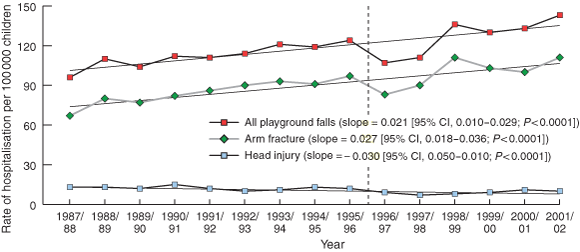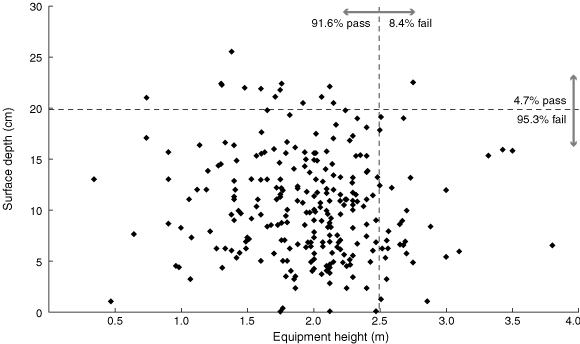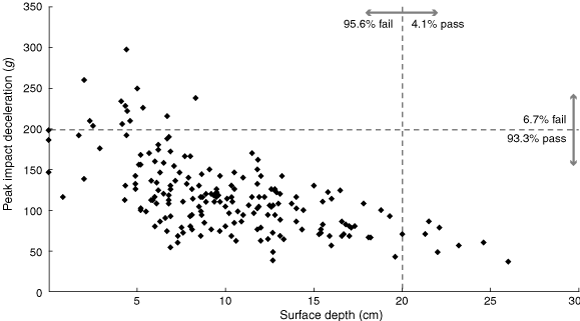Playground-related injury is a common childhood occurrence, representing about 6% of all hospital-treated childhood injuries.1 In Victoria, 22% of children presenting to hospital with playground-related injury are admitted1 and medical treatment costs are about $7.9 million per year (1996/97).2
Most injuries result from a fall from playground equipment located at school, in public parks or at home.1,3 Upper-limb fracture is the most common injury, accounting for 43% of playground injury presentations to hospital emergency departments and 74% of hospital admissions for playground injury in children.1
Risk factors for playground injury include the height of the equipment from which the child falls and the nature of the surface onto which he or she lands.4-8 Current playground safety standards aim to minimise the risk of potentially fatal head injury, with measures of surface-impact attenuation (peak impact deceleration < 200g and head injury criterion [HIC] < 1000) used to define safe playgrounds.9-12 (For definitions of some key terms, see Box 1.)
Through laboratory-based testing,13,14 critical head-injury measures have been interpreted in some countries to correspond to maximum equipment heights not exceeding 2.5 m and minimum surface depths of 20 cm.10,11 Other countries’ standards provide key headform impact guidelines without translating these into recommended equipment heights or surface depths.9,12
Population-based hospitalisation rates for playground injuries have been increasing steadily in Victoria, with primarily arm fracture, not head injury, driving this trend (Box 2). This is despite the introduction of stricter playground standards in 1996.11 This trend raises the question of whether playgrounds where children sustain arm fractures comply with current safety standards and, if so, whether current playground safety standards are adequate for preventing arm fractures.
The aim of our study was to investigate the extent to which playgrounds where fall-related arm fractures occur comply with safety standards for equipment height and surface type and depth. The study was part of a larger case controlled study of risk factors for arm fracture.15
A consecutive prospective case series study of playground fall-related arm fractures was conducted from October 2000 to December 2002. Emergency department staff at five participating hospitals in Victoria electronically reviewed medical records weekly to identify cases. Our criteria for selection specified children aged under 13 years; falling from fixed playground equipment; located at school or preschool; and resulting in a fracture of the humerus, radius, ulna, or a combination of these bones. Fracture diagnosis was confirmed by a treating physician, and corresponded to ICD-10-AM codes S42.2, S42.3, S42.4, S52, S62.0, S62.1, S62.8 and T10 as seen on x-ray.16
Field measurements included equipment height and surface type and depth. The maximum height of the equipment was measured as the vertical distance from the surface to the highest accessible part of the structure.17 Surface depth was measured (for loose-fill surfaces only) as the average of three probe readings taken 30 cm apart in a triangle around the surface impact location. If the surface had been modified after the fall, child details were recorded but surface depth and equipment height were excluded.
Peak impact deceleration was measured using a triaxial accelerometer headform (Playground Clearing House MAX G/SI, Phoenixville, Pa) in a standard drop-test procedure.11 Instrumentation has been previously described and output validated.15 Headform impact tests were conducted from the maximum height of the equipment. Deceleration/time curves were generated, from which peak impact deceleration and HIC were derived, and the worst outcome of three drop tests was included in the analysis.11
As availability of the playground headform was limited, surface impact tests were undertaken in only 50% of playgrounds. Independent t-tests were conducted to detect any significant difference between headform-tested and non-headform-tested groups.
We calculated the mean and standard deviation of each variable measured and determined the proportion of playgrounds complying with Australian playground safety standards.11,17
There were 624 identified children with playground fall-related arm fracture presenting to the five hospitals during the study period. Of these, 179 (28.7%) were not included in the analysis because their families could not be contacted after five attempts by telephone; 26 (4.2%) and 17 (2.7%), respectively, were from families and schools that declined to participate.
The final series comprised 402 cases (a 64.4% recruitment rate). Participants included 175 boys (43.5%) and 227 girls (56.5%) (for a summary of measurements relating to the group, see Box 3).
For the 402 playground fall-related arm fractures investigated, 98.0% occurred on recommended surface material, namely tanbark (n = 389), sand (n = 4) and rubber (n = 1). Eight playgrounds (2.0%) had non-recommended surface material: soil (n = 5), grass (n = 1), mat (n = 1) and wood (n = 1).
Playground surface modification between the time of the child’s injury and the time of measurement (mean, 20.6 days; SD, 10.4 days) resulted in 32 cases (8.0%) being excluded from surface depth and equipment height measurements and analyses. Playground equipment height was thus measured in 370 playgrounds (92.0%). Nine playgrounds had surfaces (eg, grass, rubber) whose depth was not measurable, leaving 361 playgrounds (89.8%) for which surface depth could be reported.
Summary results for playground equipment height, surface depth, peak impact deceleration and HIC, where measurable, are presented in Box 3.
Although the recommended surface material was often installed, only 17 playgrounds (4.7%) complied with the standard recommended 20 cm surface depth (Box 4).
Most playgrounds (91.6%) complied with the 2.5 m equipment height recommendation (Box 4). Thirty of the 31 playgrounds (96.8%) that did not comply with equipment height recommendations also did not comply with surface depth recommendations.
Most playgrounds (94.4% and 86.2%, respectively) complied with the recommendations that peak impact deceleration should not exceed 200g and HIC should not exceed 1000 (Box 5). Notably, only 6.7% of playgrounds in this series that failed surface depth tests also failed to conform with peak impact deceleration guidelines (Box 6).
The degree of compliance of each measured variable with current safety standards is summarised in Box 7.
The major finding of our study was that over 86% of the playgrounds assessed complied with current Australian standards in terms of surface material type, equipment height, and measures of surface impact attenuation (peak impact deceleration and HIC). The study also established that correct surface material was installed in 98% of playgrounds, although surface depth compliance was poor (4.7%). Another study reported 16% surface depth compliance in NSW council playgrounds,19 and our own previous audit of 176 pieces of school playground equipment revealed only 5.7% surface depth compliance (unpublished data).
Surface depth recommendations are included in the standard as simplified proxy guidelines to compliance with playground surface impact attenuation requirements. However, surface depth alone is not a reliable predictor of surface impact attenuation. Our results indicate that arm fracture often occurs in playgrounds that comply with current safety standard impact attenuation guidelines. The mean impact attenuation values (peak impact deceleration, 119g; HIC, 615) were well below the currently recommended limits of 200g and 1000. This finding implies that current playground safety standards are inadequate to address the risk of arm fracture.
There has been some discussion in Australia and overseas about simplifying the standards for playground equipment by adopting only one of the two measures of surface impact attenuation. However, despite a high correlation between peak impact deceleration and HIC values (r2 = 0.92), reliance on peak impact deceleration measures alone as a critical safety guide may underestimate the risk of playground injury (Box 5). By including specific injury criteria such as HIC, safety standards would define about 8% more playgrounds in this series as non-compliant.
Strengths of our study include the large sample size, the standard protocol under which it was conducted, validated child interviews and validated field measures of peak impact deceleration and HIC. This case series reveals new and important observations that emphasise the need to further investigate risk factors for arm fracture in children who fall from playground equipment. Limitations of our study include the fact that it was conducted primarily on tanbark surfacing and related only to falls from static playground equipment. A lack of statistical power precluded any stratification of results by age groups.
Playground fall-related arm fracture requires specific countermeasures for prevention, distinct from head-injury prevention guidelines. We believe that injury criteria more closely related to the risk of arm fracture should be developed and included in revised playground safety standards to complement HIC as a guide to playground safety.
1: Glossary of key terms
Drop test: A series of impact measurements conducted by dropping an instrumented headform from the maximum accessible height of a piece of playground equipment to the ground.
Headform: A head-shaped structure designed for testing the potential effect on the human head of high-impact trauma. A triaxial accelerometer headform is one that contains three accelerometers positioned orthogonally to obtain an accurate measure of the deceleration/time trace.
Head injury criterion (HIC): HIC is calculated from the deceleration/time trace of a headform drop test and is a predictor of the probability of fatal head injury. An HIC value ≥ 1000 is considered indicative of an unacceptably high risk of fatal head injury.
Peak impact deceleration: The maximum deceleration experienced during an initial impact. It is expressed as a multiple of the acceleration constant g (9.8 m/s2).
Surface impact attenuation: A measure of the degree to which a surface material deforms, on impact, to reduce the amount of deceleration of the impacting object.
2: Trends in rates of hospitalisation for arm fracture and head injury in children who fall from playground equipment, Victoria, Australia*

* The dashed line indicates the introduction of stricter playground safety standards (in 1996). Source: Victorian inpatient minimum dataset, children aged less than 15 years.
3: Summary of child and playground characteristics in cases of fall-related arm fracture
|
n |
Mean |
SD |
Minimum |
Median |
Maximum |
|||||
Child characteristics |
|||||||||||
Age (years) |
402 |
7.1 |
1.8 |
2.0 |
7.0 |
12.0 |
|||||
Child height (m) |
402 |
1.28 |
0.11 |
0.98 |
1.27 |
1.54 |
|||||
Child weight (kg) |
402 |
28.0 |
7.9 |
14.0 |
26.0 |
60.0 |
|||||
Playground characteristics |
|||||||||||
Body mass index (kg/m2) |
402 |
16.8 |
2.5 |
11.9 |
16.3 |
26.0 |
|||||
Equipment height (m) |
370 |
2.04 |
0.43 |
0.41 |
2.30 |
3.70 |
|||||
Surface depth (cm) |
361 |
11.1 |
5.0 |
0 |
10.5 |
26.0 |
|||||
Peak impact deceleration (g) |
198 |
119 |
46 |
36 |
113 |
298 |
|||||
Head injury criterion (HIC) |
198 |
615 |
338 |
53 |
517 |
3311 |
|||||
4: Surface depth and equipment height compliance in 361 cases of arm fracture in children (dotted lines denote recommended limits)

5: Peak impact deceleration and HIC compliance in 198 cases of arm fracture in children (dotted lines denote recommended limits)

HIC = head injury criterion.
6: Surface depth and peak impact deceleration compliance in 198 cases of arm fracture in children (dotted lines denote recommended limits)

7: Summary of compliance of playgrounds with recommended Australian safety standards11,17
Variable |
Compliance rate |
||||||||||
Equipment height |
91.6% |
||||||||||
Surface material |
98.0% |
||||||||||
Surface depth |
4.7% |
||||||||||
Peak impact deceleration |
94.4% |
||||||||||
Head injury criterion (HIC) |
86.2% |
||||||||||
- Shauna Sherker1
- Joan Ozanne-Smith2
- Accident Research Centre, Monash University, Melbourne, VIC.
This work is funded by the Australian National Health and Medical Research Council (project no. 124414), the Victorian Health Promotion Foundation, the Victorian Department of Human Services and a Monash University Postgraduate Publication Award.
The authors wish to thank George Rechnitzer, Monash University Accident Research Centre (MUARC), and Raphael Grzebieta, Monash University Department of Civil Engineering, for technical advice, and Jim Nixon, University of Queensland, for loan of the playground headform. We also thank Angela Clapperton, Victorian Injury Surveillance and Applied Research System, for providing data for playground hospitalisations and trend analysis; Stuart Newstead, MUARC, for statistical advice; and Lesley Day, MUARC, for valuable comment on the manuscript. Barbara Fox, Belinda Clark, Haisam Askari, Nebojsa Tomasevic and Chris Brennan assisted with data collection.
None identified.
- 1. Altmann A, Ashby K, Stathakis V. Childhood injuries from playground equipment. Hazard Dec 1996; No. 29. Melbourne: Monash University Accident Research Centre.
- 2. Watson W, Ozanne-Smith J. The cost of injury to Victoria. Report No. 124. Melbourne: Monash University Accident Research Centre, 1997.
- 3. Lam L, Ross F, Cass D. Children at play: the death and injury pattern in New South Wales, Australia, July 1990–June 1994. J Paediatr Child Health 1999; 35: 572-577.
- 4. Chalmers DJ, Marshall SW, Langley JD, et al. Height and surfacing as risk factors for injury in falls from playground equipment: a case-control study. Inj Prev 1996; 2: 98-104.
- 5. Laforest S, Robitaille Y, Lesage D, Dorval D. Surface characteristics, equipment height, and the occurrence and severity of playground injuries. Inj Prev 2001; 7: 35-40.
- 6. Macarthur C, Hu X, Wesson DE, Parkin PC. Risk factors for severe injuries associated with fall from playground equipment. Accid Anal Prev 2000; 32: 377-382.
- 7. Mowat DL, Wang F, Pickett W, Brison RJ. A case-control study of risk factors for playground injuries among children in Kingston and area. Inj Prev 1998; 4: 39-43.
- 8. Mott A, Rolfe K, James R, et al. Safety of surfaces and equipment for children in playgrounds. Lancet 1997; 349: 1874-1876.
- 9. Canadian Standards Association. CAN/CSA-Z614-98: children’s playspaces and equipment. Toronto: CSA, 1998.
- 10. Comité Européen de Normalisation. CEN 1177: impact absorbing playground surfacing — safety requirements and test methods. Brussels: CEN, 1997.
- 11. Standards Australia/New Zealand. AS/NZS 4422: playground surfacing — specifications, requirements and test methods. Wellington: SA/NZ, 1996.
- 12. American Society for Testing Material. ASTM F1292: standard specification for impact attenuation of surface systems under and around playground equipment. Philadelphia, Pa: ASTM, 1991.
- 13. Murgatroyd J, Bullen F. Shock absorbing surfaces for children’s playgrounds. In: Proceedings of the International Conference on the Biomechanics of Impacts; 1990 Sep 12-14; Bron, France. Lyon, France: International Research Council on the Biomechanics of Impact, 1990.
- 14. Lewis LM, Naunheim R, Standeven J, Naunheim KS. Quantitation of impact attenuation of different playground surfaces under various environmental conditions using a triaxial accelerometer. J Trauma 1993; 35: 932-935.
- 15. Sherker S, Ozanne-Smith J, Rechnitzer G, Grzebieta R. The development of a multidisciplinary method to determine risk factors for arm fracture in falls from playground equipment. Inj Prev 2003; 9: 279-283.
- 16. National Centre for Classification in Health. International statistical classification of diseases and related health problems, 10th revision, Australian Modification (ICD-10-AM). Sydney: NCCH, 1998.
- 17. Standards Australia. AS 1924-1: playground equipment for parks, schools and domestic use — general requirements. Sydney: Standards Australia, 1981.
- 18. National Health and Medical Research Council. National statement on ethical conduct in research involving humans. Canberra: NHMRC, 1999.
- 19. Witheaneachi D, Meehan T. Council playgrounds in New South Wales: compliance with safety guidelines. Aust N Z J Public Health 1997; 21: 577-580.





Abstract
Objective: To assess compliance with current standards of playgrounds where children have sustained a fall-related arm fracture.
Design, setting and participants: Between October 2000 and December 2002, a consecutive prospective series of 402 children aged under 13 years who fell from playground equipment and sustained an arm fracture was identified by emergency department staff in five Victorian hospitals. Trained field testers measured playground equipment height, surface type and depth, and surface impact attenuation factors to determine compliance with safety standards.
Main outcome measures: Playground compliance with current Australian safety standards.
Results: Ninety-eight percent of playgrounds had a recommended type of surface material. The mean surface depth was 11.1 cm (SD, 5.0 cm) and the mean equipment height was 2.04 m (SD, 0.43 m). Although over 85% of playgrounds complied with recommended maximum equipment height and surface impact attenuation characteristics, only 4.7% complied with recommended surface depth.
Conclusion: Playgrounds where children have sustained an arm fracture generally comply with all important safety recommendations except surface depth. Playground fall-related arm fracture requires specific countermeasures for prevention, distinct from head injury prevention guidelines.